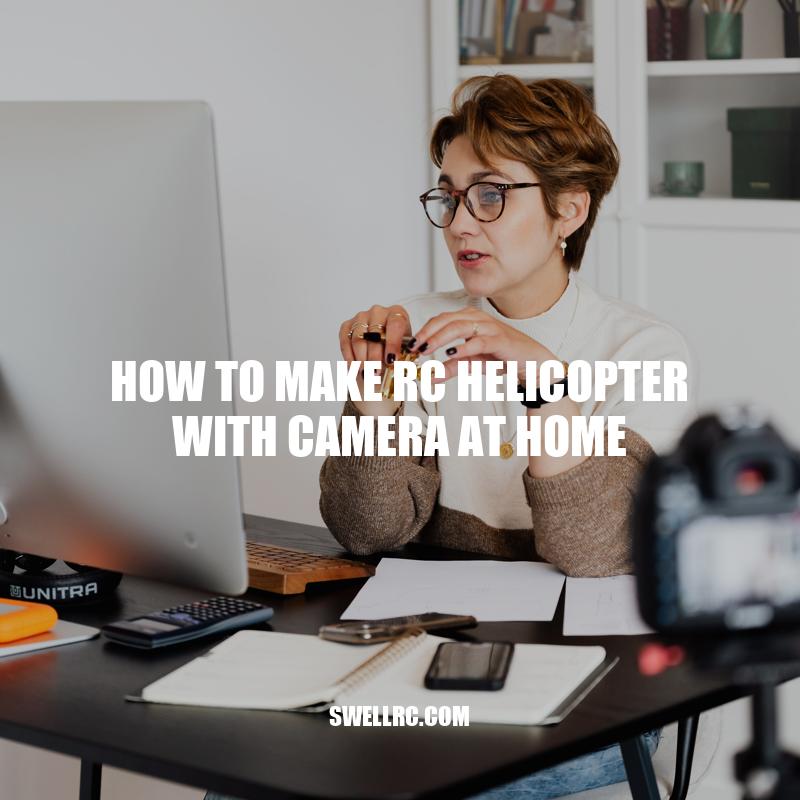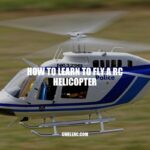How to Make an RC Helicopter with Camera at Home
RC helicopters with cameras have gained immense popularity over the years due to their ability to capture stunning aerial footage. These aerial vehicles are widely used in various industries like filmmaking, real estate, and construction. However, buying a ready-made RC helicopter with a camera can be quite expensive, which is why many people opt to make one themselves. It is a fun and engaging project that requires minimal investment and provides hours of entertainment. With a little bit of patience and some essential tools, you can create your very own aerial vehicle that captures breathtaking footage from a bird’s eye view. In this article, we will guide you on how to make an RC helicopter with a camera at home. We will take you through the step-by-step process and provide tips to ensure a successful build. Whether you’re a beginner or an experienced hobbyist, our guide is tailored to accommodate all skill levels. So without further ado, let’s get started on this exciting DIY project!
Materials Required
To make an RC helicopter with a camera, you will need the following materials:
- A drone kit
- A camera module
- A controller
- A battery
- A soldering iron
- A transmitter/receiver module
- An antenna for transmission
- Some basic tools like wire cutters and pliers
You can find all these materials online or at your local electronics store. When buying a drone kit, make sure it matches your skill level and includes all the necessary components to build the drone. Some popular drone kits you can use include:
- The DJI Innovations Flamewheel kit
- The CX-20 Auto-Pathfinder kit
- The F450 quadcopter kit
Once you have all the materials in-hand, you can begin the exciting journey of assembling your very own RC helicopter with a camera.
Is it cheaper to build your own drone?
Building your own drone might seem like a cost-effective option, but the answer isn’t straightforward. Here are a few things to consider before deciding:
- The cost of individual components for building a drone can add up quickly.
- Professionally built drones come with a warranty, which can be beneficial in case you encounter any issues.
- Building your own drone also requires specialized knowledge and skills that you might not possess, in which case, it might not be cheaper in the long run.
There are websites like Build-a-Drone that offer kits to build your drone, which might be a good option for those who want to learn and assemble a drone on their own. However, before making a decision, be sure to weigh the costs and benefits of building versus buying a drone.
Assembling the Drone
Assembling an RC helicopter with a camera can be a challenging task, but with the right instructions and guidance, you can do it. Here are the steps to assemble an RC helicopter with a camera:
| Steps | Description |
|---|---|
| Step 1 | Begin by opening the drone kit and identifying all the components. |
| Step 2 | Next, attach the arms to the body of the drone and secure them with screws. |
| Step 3 | Connect the motor wires to the speed controllers and attach them to the arms. |
| Step 4 | Install the flight controller and antenna on the top of the drone as per the instructions. |
| Step 5 | Connect the camera module and transmitter to the drone. |
| Step 6 | Attach the landing gear and battery, ensuring a proper balance of the drone for smooth hovering. |
| Step 7 | Test and calibrate the drone using instructions provided with the kit. |
With these simple steps, you can assemble your RC helicopter with a camera and take it out for some adventurous flying. Don’t forget to read the instructions carefully, and if necessary, seek help from online forums or tutorial videos for better understanding.
Can you put a camera on a RC helicopter?
Yes, you can put a camera on an RC helicopter. In fact, many high-end RC helicopters come with built-in cameras or have camera mounts that you can attach to them. There are also camera mounting kits available online that you can purchase to attach to your existing RC helicopter.
Some popular camera options for RC helicopters include GoPro Hero cameras and DJI Osmo Action cameras. These cameras are compact and lightweight, making them ideal for mounting on an RC helicopter.
When choosing a camera for your RC helicopter, you should consider factors such as weight, resolution, and stabilization. You’ll also want to ensure that the camera is compatible with your RC helicopter and that the mounting system is secure.
Overall, adding a camera to your RC helicopter can enhance your flying experience and allow you to capture stunning aerial footage. Check out websites like Amazon or B&H Photo Video for camera options and mounts.
Building the Controller
Building a controller for your RC helicopter with a camera can be a fun process, and with a little effort, you can create a custom controller to suit your needs. Here are the steps to build a controller for your RC helicopter:
| Steps | Description |
|---|---|
| Step 1 | Choose a controller board like an Arduino or Raspberry Pi to build your controller. |
| Step 2 | Install the necessary software and drivers to run the controller board on your computer. |
| Step 3 | Connect the receiver module to the controller board, and solder wires as per the instructions. |
| Step 4 | Use the open-source software provided to program the controller, and assign the buttons to the functions. |
| Step 5 | Attach the joysticks and buttons to the controller and make sure they are functioning correctly. |
| Step 6 | Switch on the controller and synchronize it with the drone, and you are ready to fly. |
Building a custom controller can be a rewarding experience and can enhance your flying experience, giving you more controls and features. You can purchase a controller if you prefer not to build one, or check out websites like hobbyking.com or amazon.com to search for the required components.
How do you control a helicopter?
Controlling a helicopter involves manipulating the main rotor and tail rotor blades to achieve lift, direction and stability. The primary controls are as follows:
- Collective lever: controls the collective pitch of the main rotor blades to increase or decrease lift
- Cyclic stick: tilts the main rotor in a particular direction to control forward, backward, left or right movement
- Tail rotor pedals: changes the pitch of the tail rotor blades to counteract torque produced by the main rotor and control the yaw of the helicopter
In addition to these primary controls, there are several secondary controls that help to fine-tune the helicopter’s movements.
If you’re interested in learning more about helicopter controls, check out helicopter pilot training programs offered by aviation schools or browse online resources such as helicopter-specific websites and forums.
Testing and Calibration
Before taking your RC helicopter with a camera on its first flight, it’s crucial to test and calibrate it to ensure safe and smooth operation. Here are the steps to test and calibrate your RC helicopter:
- Check the batteries are fully charged for both the drone and controller.
- Use a simulator program to test the drone’s controls and operation. This will help you get familiar with the controls before you fly the actual drone.
- Perform a pre-flight checklist that includes checking the motor and propeller functioning, the tightness of screws, and other critical elements.
- Calibrate the drone’s sensors, including the gyroscope and accelerometer.
- Check the camera module and ensure it’s functioning correctly.
- Perform a test flight in an open and safe area, and take note of any issues or complications that arise during the flight.
Before you take your RC helicopter on a test flight, make sure you are aware of the local regulations around flying drones, especially if you plan to use it in public areas. Always fly the drone in a safe and controlled environment to avoid any accidents, and follow the manufacturer’s instructions carefully. If you face any difficulties, you can check out websites like rcgroups.com or quadcopters.co.uk, which offer forums and tutorials on RC helicopter building and flying.
How do you calibrate a RC helicopter?
Calibrating an RC helicopter is necessary to ensure that it flies accurately and safely. Follow these simple steps to calibrate your RC helicopter:
- Turn on the transmitter and helicopter
- Place the helicopter on a flat surface
- Adjust the trim settings to center the controls
- Bind the helicopter and transmitter if necessary
- Calibrate the gyro using the manufacturer’s instructions
- Check the pitch angle and adjust if necessary
- Test the helicopter’s flight and readjust if needed
For more detailed instructions on calibrating your specific RC helicopter model, refer to the manufacturer’s manual or visit their website. Websites like Horizon Hobby and RC Groups also provide helpful resources for RC helicopter enthusiasts.
Flying and Recording
Finally, it’s time to fly your RC helicopter with a camera and capture stunning aerial footage. Here are some essential tips for flying and recording with your RC helicopter:
- Tip 1: Start with simple maneuvers, such as hovering and moving in different directions before attempting complicated movements.
- Tip 2: Ensure the drone is always within your sight to avoid accidents or flying it into a forbidden area.
- Tip 3: Use the camera module’s features, such as adjusting the camera angle, to capture unique and stunning footage.
- Tip 4: Experiment with different flight modes, such as altitude hold or headless mode, to improve your flying technique and achieve better footage.
- Tip 5: If you have any difficulties or problems with your RC helicopter, you can refer to online communities such as rcgroups.com and get expert advice from experienced enthusiasts.
Remember to follow safety guidelines and regulations when flying your RC helicopter, such as avoiding flying over people, animals, or private property without permission. Submit any footage you capture on social media platforms or YouTube to show off your skills and creativity. Happy flying!
Are RC helicopters better than drones?
Both RC helicopters and drones have their own advantages and disadvantages, making it difficult to definitively say if one is better than the other. Here are some factors to consider:
Price: Generally, RC helicopters are less expensive than drones.
Maneuverability: RC helicopters tend to be more difficult to control than drones, but they can be flown more precisely once mastered.
Camera capabilities: Drones are typically better equipped with cameras and video capabilities than RC helicopters.
Usage: RC helicopters are better suited for indoor flying, while drones are better for outdoor flying due to their GPS capabilities.
Ultimately, the choice between RC helicopters and drones comes down to personal preference and intended usage.
If you’re interested in purchasing an RC helicopter or drone, be sure to do your research and read reviews to find the best product for you. Websites like Amazon and Best Buy offer a selection of both types of products with customer reviews to help guide your decision.
Conclusion
Making an RC helicopter with a camera at home is an exciting and rewarding experience. With the right materials and a step-by-step guide, you can build a flying device that captures stunning aerial footage. Remember to take safety precautions, such as flying the drone at a safe altitude and complying with regulations.
By following the steps outlined in this article, you can create your very own RC helicopter with a camera and gain valuable skills that will serve you well in the future. You can also use the footage you capture for various purposes, such as creating YouTube videos or surveying hard-to-reach areas. The possibilities are endless.
With online resources like drone enthusiast communities, you can get additional support, tips, and advice to make your RC helicopter with a camera project more successful. Embrace the possibilities of this project and enjoy the process of creating your own flying device that captures stunning photos and videos. So, let’s get started!



